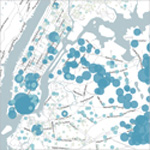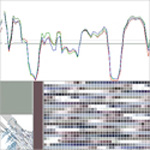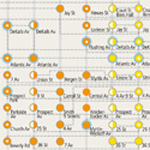KEYWORDS
Cartography, comparative education, data visualization, decision support, education, open data
ABSTRACT
How does a parent choose the best school for their child? Dust is an ongoing research project developed for Iridescent, an American NGO. The project’s aim is to provide a freely available, web based information visualization tool that supports parents in exploring and comparing the educational offerings (from Pre-K to High School) from selected major cities in the United States, currently: New York, Los Angeles, and the San Francisco Bay Area. By leveraging a step-by-step decision making process, Dust helps to evaluate and compare school profiles based on multidimensional data-sets composed of general information (e.g., enrollment, class size, number of teachers), school performances (e.g., subjects score and proficiency, attendance), and urban mobility (e.g., location, distances, transportation). Supported by geographical maps and close-up visualizations users can create custom profiles based on their needs and priorities and then perform a search for the most appropriate schools for their children. Dust aims to combine the capability of information visualization in depicting synthetic views of complex, multidimensional, and georeferenced data; with a rich, yet intuitive, web-user experience. The project aims to move away from a “by experts, for experts” design paradigm to a schools comparison information visualization “for the people”—providing real impact on their daily life, and future prospects, through improved choices.
BIOGRAPHY
Matteo Azzi received his master’s degree in Communication Design in 2011. Currently Mr. Azzi serves as a researcher at the DensityDesign Lab. He specializes in the field of data and information visualization; Mr. Azzi’s interest has a heavy focus on the relationship between analog and digital environments within the interaction field.
Giorgio Caviglia has a master’s degree in Communication Design and is currently a PhD student in design at Politecnico di Milano. His research focuses on the study and the design of visualization tools for humanities and the social sciences disciplines. In 2008 he joined DensityDesign Lab. Currently, he is a teaching Assistant at the Politecnico di Milano and a visiting researcher for Stanford University.
Donato Ricci is a Senior Designer at DensityDesign Lab. In 2010 he earned a PhD degree summa cum laude in Industrial Design and Multimedia Communication at Politecnico di Milano with his dissertation “Seeing what they are saying: Diagrams for social complexity and controversies.” At DensityDesign Lab he carries out scientific research, design project fulfillment, and teaching activities in the field of visual epistemology. He is also Visiting Professor of Knowledge and Representation at the Universidade de Aveiro, Portugal.
Paolo Ciuccarelli is the founder and scientific coordinator of POLIteca, the Design Knowledge Centre of Politecnico di Milano. His research and publishing activities focus on the development of data, information and knowledge visualization tools and methods to support decision making processes in complex systems. In addition, Mr. Ciuccarelli serves as Associate Professor at Politecnico di Milano, teaching at the Faculty of Design in the Communication Design master degree. He has been visiting lecturer at Universidad de Malaga and The Royal Institute of Art (KKH, Stockholm).
Emanuele Bonetti is a graphic designer who earned his degree in Visual Communication Design at Politecnico di Milano. He worked in London before going to Rotterdam where he completed his master’s degree in Networked Media at the Piet Zwart Institute. He is a co-founder of parcodiyellowstone, a design collective. He pursues design with open source cultures, new media, and design ethics.
Loredana Bontempi received her bachelor degree in Visual Communication Design from Politecnico di Milano. She is a co-founder of the design group parcodiyellowstone. Ms. Bontempi graduated with a master’s Degree in Media Design and Communication from the Piet Zwart Institute in Rotterdam. Loredana currently works in Italy where she is further developing work concentrating on free culture and media design ethics.





